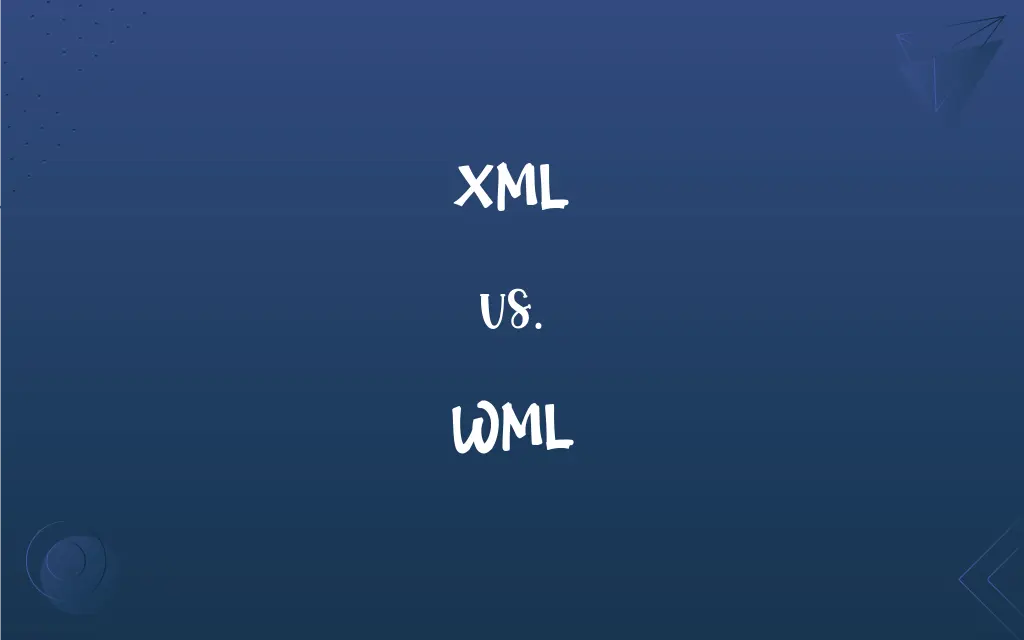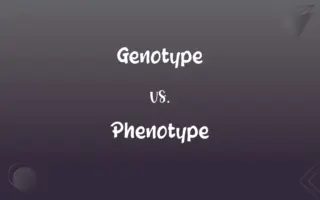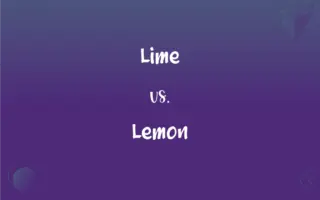XML vs. WML: What's the Difference?
Edited by Aimie Carlson || By Harlon Moss || Updated on October 11, 2023
XML is a markup language for encoding documents, while WML is a markup language tailored for mobile devices.

Key Differences
XML, or eXtensible Markup Language, is a language designed to store and transport data in a structured format. WML, or Wireless Markup Language, is a language developed for devices that operate over wireless communication networks.
XML is versatile and can be used in various applications such as web services, configuration files, and data storage. On the other hand, WML was specifically designed for small screens and limited bandwidths commonly found in mobile devices.
Both XML and WML have the ability to represent data in a structured manner. However, while XML is more generic and used in a wide range of applications, WML is narrowly focused on providing web content for wireless devices.
Another notable distinction is that XML has gained universal recognition and has a broad user community, while WML has become less prominent with the rise of more advanced mobile web technologies.
Comparison Chart
Primary Use
Encoding data for both humans and machines to read.
Tailored for mobile devices with limited bandwidth.
ADVERTISEMENT
Generality
General-purpose markup language.
Specific to wireless communications.
Syntax
Uses a standard syntax that can represent complex data structures.
Has a more simplified syntax for small screens.
Popularity
Widely used in various applications.
Declined in use due to modern mobile web technologies.
Extensions
Can be extended using XML Schema or DTD.
Can be extended but less flexibly than XML.
XML and WML Definitions
XML
XML is a markup language designed to describe data.
The configuration file was written in XML.
ADVERTISEMENT
WML
WML is a markup language for wireless devices.
Early mobile phones used WML to display web content.
XML
XML is a way to structure data for sharing between applications.
The software exports the user's data in an XML format for portability.
WML
WML is based on XML and was a predecessor to modern mobile web standards.
Before smartphones, WML played a pivotal role in mobile web browsing.
XML
XML allows for custom tags to define data structures.
With XML, you can create a tag like to represent books in a library system.
WML
WML stands for Wireless Markup Language.
The website provides a WML version for older mobile browsers.
XML
XML stands for eXtensible Markup Language.
XML has become a standard for data interchange on the web.
WML
WML is tailored for small screens and limited bandwidths.
WML pages are lightweight to ensure faster loading times on mobile devices.
XML
XML is both human-readable and machine-readable.
Programmers can easily edit XML files using standard text editors.
WML
WML uses cards and decks as its main concepts.
In WML, a deck can contain multiple cards representing individual screens.
XML
An international standard metalanguage for creating markup languages that structure digital information in a way that allows for the exchange, display, and storage of data independent of proprietary operating systems and hardware devices.
FAQs
What is WML used for?
WML is used for presenting content on wireless devices, especially older mobile phones.
Is WML still widely used today?
No, WML's popularity has declined with the rise of advanced mobile web technologies.
What does XML stand for?
XML stands for eXtensible Markup Language.
Can WML be viewed on modern browsers?
Most modern browsers don't natively support WML without plugins or converters.
What are the main structures in WML?
WML uses concepts like cards and decks to structure content.
How do XML and WML handle data attributes?
Both XML and WML can represent attributes, but their usage might differ based on context.
What is the main advantage of XML over other data formats?
XML is versatile, platform-neutral, and both human and machine-readable.
Can XML define its own tags?
Yes, XML allows users to define custom tags to describe data structures.
What are the alternatives to WML for modern devices?
Modern devices usually rely on technologies like HTML5 and CSS3 for web content.
Can I convert XML to WML or vice versa?
Yes, with the right tools or scripts, conversion between XML and WML is possible.
Is XML similar to HTML?
While both are markup languages, XML is for encoding data, whereas HTML is for presenting data.
Is XML case-sensitive?
Yes, XML is case-sensitive.
Can XML be used for web pages?
While XML can be used in web technologies, it's primarily for data representation, not display.
Can XML store metadata about its data?
Yes, XML can store metadata using attributes within its tags.
Is XML a programming language?
No, XML is a markup language, not a programming language.
Why has WML become less popular?
With the advent of smartphones and modern mobile web technologies, the need for WML has decreased.
Is WML based on XML?
Yes, WML is an application of XML tailored for mobile devices.
Why was WML created?
WML was created to deliver web content to mobile devices with limited capabilities.
What does WML stand for?
WML stands for Wireless Markup Language.
Are XML documents easily readable by humans?
Yes, XML is both human-readable and machine-readable.
About Author
Written by
Harlon MossHarlon is a seasoned quality moderator and accomplished content writer for Difference Wiki. An alumnus of the prestigious University of California, he earned his degree in Computer Science. Leveraging his academic background, Harlon brings a meticulous and informed perspective to his work, ensuring content accuracy and excellence.
Edited by
Aimie CarlsonAimie Carlson, holding a master's degree in English literature, is a fervent English language enthusiast. She lends her writing talents to Difference Wiki, a prominent website that specializes in comparisons, offering readers insightful analyses that both captivate and inform.































































